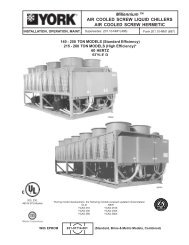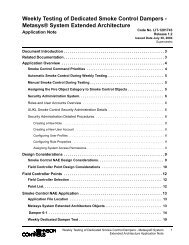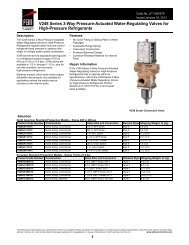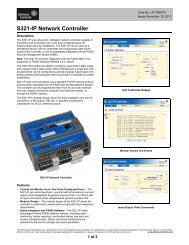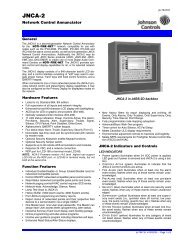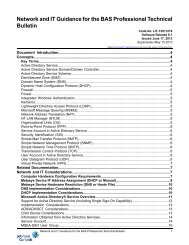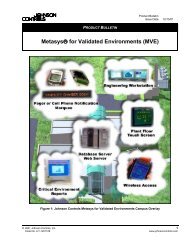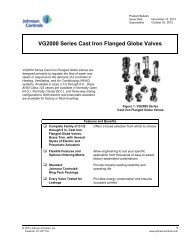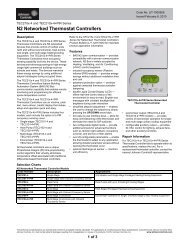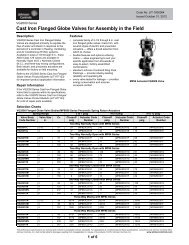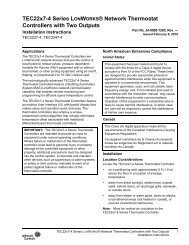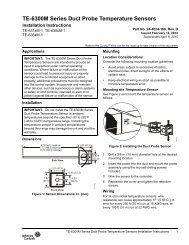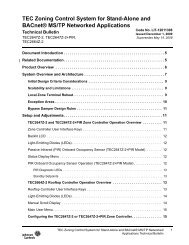YVAA Style A Air-Cooled Screw Liquid Chillers ... - Johnson Controls
YVAA Style A Air-Cooled Screw Liquid Chillers ... - Johnson Controls
YVAA Style A Air-Cooled Screw Liquid Chillers ... - Johnson Controls
Create successful ePaper yourself
Turn your PDF publications into a flip-book with our unique Google optimized e-Paper software.
FORM 201.28-NM1.1<br />
ISSUE DATE: 8/29/2012<br />
The liquid must enter the evaporator at<br />
the inlet connection. The standard inlet<br />
connection for the evaporator is opposite<br />
the control panel end of the evaporator.<br />
A flow switch must be installed in the<br />
customer piping at the outlet of the evaporator<br />
and wired back to the control panel<br />
using shielded cable.<br />
There should be a straight run of piping of at least 5<br />
pipe diameters on either side. The flow switch should<br />
be wired to Terminals 2 and 13 on the 1TB terminal<br />
block. A flow switch is required to prevent damage to<br />
the evaporator caused by the unit operating without adequate<br />
liquid flow.<br />
The flow switch used must have gold plated contacts<br />
for low voltage/current operation. Paddle type flow<br />
switches suitable for 10 bar (150 PSIG) working pressure<br />
and having a 1" N.P.T. connection can be obtained<br />
from <strong>Johnson</strong> <strong>Controls</strong> as an accessory for the unit. Alternatively,<br />
a differential pressure switch fitted across<br />
an orifice plate may be used, preferably of the high/low<br />
limit type.<br />
The chilled liquid pump(s) installed in the piping<br />
system(s) should discharge directly into the unit evaporator<br />
section of the system. The pump(s) may be controlled<br />
by the chiller controls or external to the unit.<br />
Pipework and fittings must be separately supported to<br />
prevent any loading on the evaporator. Flexible connections<br />
are recommended which will also minimize<br />
transmission of vibrations to the building. Flexible<br />
connections must be used if the unit is mounted on<br />
anti-vibration mounts, as some movement of the unit<br />
can be expected in normal operation.<br />
Piping and fittings immediately next to the evaporator<br />
should be readily de-mountable to enable cleaning before<br />
operation, and to facilitate visual inspection of the<br />
exchanger nozzles.<br />
The evaporator must be protected by a<br />
strainer, preferably of 40 mesh, fitted as<br />
close as possible to the liquid inlet connection,<br />
and provided with a means of local<br />
isolation.<br />
SECTION 4 - INSTALLATION<br />
The evaporator must not be exposed to flushing velocities<br />
or debris released during flushing. It is recommended<br />
that a suitably sized bypass and valve arrangement<br />
is installed to allow flushing of the piping system.<br />
The bypass can be used during maintenance to isolate<br />
the heat exchanger without disrupting flow to other<br />
units.<br />
Thermometer and pressure gauge connections should<br />
be provided on the inlet and outlet connections of each<br />
evaporator. Gauges and thermometers are not provided<br />
with the unit and are to be furnished by others.<br />
Drain and air vent connections should be provided at<br />
all low and high points in the piping to permit drainage<br />
of the system and to vent any air in the pipes.<br />
<strong>Liquid</strong> system lines at risk of freezing, due to low ambient<br />
temperatures should be protected using insulation<br />
and heater tape and/or a suitable glycol solution.<br />
The liquid pump(s) may also be used to ensure liquid<br />
is circulated when the ambient temperature approaches<br />
freezing point.<br />
Insulation should also be installed around the evaporator<br />
nozzles. Heater tape of 21 Watts per meter under<br />
the insulation is recommended, supplied independently<br />
and controlled by an ambient temperature thermostat<br />
set to switch ON at approximately 2.2°C (4°F), above<br />
the freezing temperature of the chilled liquid.<br />
The evaporator is protected by heater mats placed under<br />
the insulation, which are powered from the unit<br />
control system power supply. During cold weather<br />
when there is a risk of freezing, chiller power should be<br />
left switched on to provide the freeze protection function<br />
unless the liquid systems have been drained.<br />
Any debris left in the water piping between<br />
the strainer and evaporator could<br />
cause serious damage to the tubes in the<br />
evaporator and must be avoided. Be sure<br />
the piping is clean before connecting it to<br />
the evaporator. Keep evaporator nozzles<br />
and chilled liquid piping capped prior to<br />
installation to assure construction debris<br />
is not allowed to enter.<br />
The installer/user must also ensure that<br />
the quality of the water in circulation is<br />
adequate, without any dissolved gases,<br />
which can cause oxidation of steel or<br />
copper parts within the evaporator.<br />
JOHNSON CONTROLS 25<br />
4



